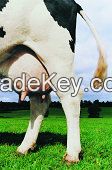
FOB Price
Get Latest Price|
Minimum Order
Place of Origin:
-
Price for Minimum Order:
-
Minimum Order Quantity:
-
Packaging Detail:
-
Delivery Time:
-
Supplying Ability:
-
Payment Type:
-
Australia
連絡先担当者 Ricky
6 Murchison Ct, Melbourne, Victoria
These black-and-white dairy cows have bloodlines from Friesland, a northern province of the Netherlands. Now known as the Holstein-Friesian, this breed is the most common milking cow in the world. It was first imported to the South Island by Canterbury farmer John Grigg in ***4, and to the North Island by Wairarapa farmers four years later. Larger numbers of Holstein-Friesians came in from the US in ****3. The breed association was formed in ***4.
Holstein-Friesians are large cows, and their milk has high concentrations of protein and lactose. In New Zealand, on a grass-only diet, they produce more than 4,**0 litres of milk from when they calve in early spring to when they dry off in autumn. In the US they can produce up to *0,**0 litres in the same period when fed high-energy supplements.
Jersey dairy cattle were first imported in ***2. During the expansion of the dairy industry from the ***0s, Jerseys were considered a good alternative to Holstein-Friesians because they gave more butterfat per litre of milk, and were smaller and easier to handle. They are slightly more efficient and profitable than Holstein-Friesians because more can be stocked per hectare of pasture. They were favoured in Taranaki, where farms were smaller. New Zealand has the worlds largest Jersey population about **0,**0.
Many New Zealand dairy farmers want medium-sized, fertile, easy-calving cattle that will not suffer leg and foot problems when travelling from paddock to parlour. In the late *0th century Holstein-Friesians were bred with Jersey cows to produce the KiwiCross, which has a dark-brown coat with white or black accents.
Hybrid vigour boosts its milk-solids production, conception and calving rates. In ***6 there were 1.2 million KiwiCross cows (about *0% of the national dairy herd), and their numbers were increasing steadily.
The red-and-white Ayrshire breed originated in Scotland and came to New Zealand in ***8 with the first settlers to Otago. The breed society was formed in ***9, and Ayrshires or their crosses now number about **0,**0. The breed performs well under all-grass, medium-intensity farming, with reliable calving, a strong constitution, good foraging abilities, strong legs and a well-shaped udder.